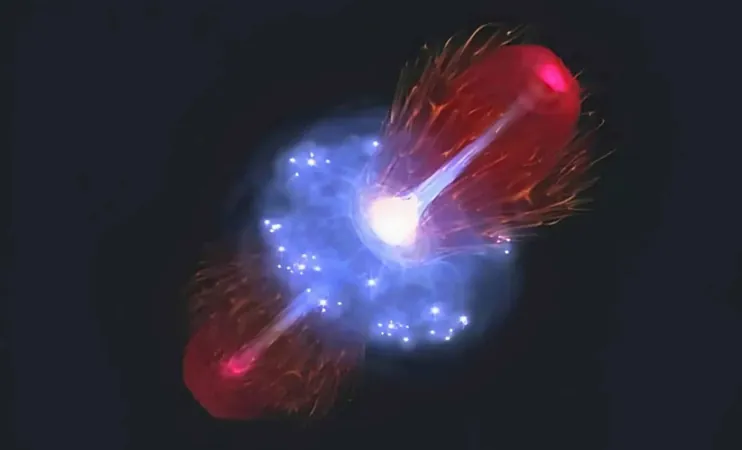
James Webb Space Telescope Discovers Dormant Supermassive Black Hole from the Early Universe
2024-12-20
Author: Ying
A Daring Discovery of Dormancy
Strikingly, this black hole holds about 40% of the mass of its host galaxy, positioning it as an extraordinary anomaly in the realm of cosmic phenomena. Typically, black holes occupy only about 0.1% of their galaxy’s mass. However, rather than actively devouring nearby matter, this supermassive black hole is in a state of dormancy, consuming material at a rate that is 100 times slower than expected. This uncommon inactivity helped researchers detect its existence under rare circumstances, allowing scientists to glean insights into its host galaxy’s mass and structure.
Ignas Juodžebalis of the Kavli Institute for Cosmology expressed excitement about the implications of this find. "Even though this black hole is dormant, its enormous size made it possible for us to detect. The early universe managed to produce some absolute monsters, even in relatively small galaxies," he remarked.
Rethinking Cosmic Growth
The existence of such a massive black hole in the early universe prompts pressing questions. Traditionally, scientists believed that supermassive black holes grew at a gradual pace through the accumulation of gas and dust over billions of years, yet this latest discovery challenges that slow-and-steady narrative.
Roberto Maiolino, another prominent researcher from the Kavli Institute, suggests two compelling theories: black holes might either form with large masses right from the start or could experience active phases (hyperactivity) punctuated by long periods of dormancy. Their simulations propose that black holes might engage in "super-Eddington accretion," which involves rapidly consuming material beyond theoretical limits, followed by extensive downtime that can span hundreds of millions of years.
"It sounds counterintuitive to explain a dormant black hole with periods of hyperactivity, but these short bursts allow it to grow quickly while spending most of its time napping," Maiolino elucidated.
The Significance of Dormant Black Holes
Detecting dormant black holes poses a significant challenge for astronomers because, unlike their active counterparts that emit luminous radiation, dormant black holes remain nearly invisible. The JWST’s advanced sensitive instruments proved pivotal in pinpointing this sleeping giant, underscoring a previously uncharted territory for astronomical research.
Maiolino pointed out that this dormant black hole's finding may represent just the tip of the iceberg: "It’s likely that the vast majority of black holes out there are in this dormant state. I’m surprised we found this one, but I’m excited to think that there are so many more we could find."
A New Era in Cosmic Studies
The implications of this discovery reach far beyond understanding individual black holes. The sheer mass and strange behavior of this dormant giant may lead to a new understanding of the interplay between black holes and their galactic environments. Traditionally, it was thought black holes influenced galaxy growth primarily through their gravitational effects. Now, researchers are reevaluating this dynamic, aware that the relationship might be more intricate than previously thought.
As studies continue, astronomers aim to delineate how periods of hyperactivity and dormancy affect both black holes and their galactic hosts. Ongoing research using JWST observations will be critical in uncovering more dormant black holes, propelling scientists toward a richer understanding of their formation and evolutionary pathways.
The Path Forward
This dramatic finding opens new exploratory channels into the universe's primitive epochs and encourages researchers to challenge established theories regarding black hole development. By illuminating new aspects of these mysterious giants, the JWST ensures that the quest to decode the secrets of the cosmos continues—a captivating journey for stargazers and scientists alike.
With each discovery, we inch closer to unearthing the profound mechanisms that have shaped our universe over billions of years. The implications of this dormant black hole could transform our comprehension of cosmic history, signaling an exciting frontier for future astronomical investigations.


 Brasil (PT)
Brasil (PT)
 Canada (EN)
Canada (EN)
 Chile (ES)
Chile (ES)
 España (ES)
España (ES)
 France (FR)
France (FR)
 Hong Kong (EN)
Hong Kong (EN)
 Italia (IT)
Italia (IT)
 日本 (JA)
日本 (JA)
 Magyarország (HU)
Magyarország (HU)
 Norge (NO)
Norge (NO)
 Polska (PL)
Polska (PL)
 Schweiz (DE)
Schweiz (DE)
 Singapore (EN)
Singapore (EN)
 Sverige (SV)
Sverige (SV)
 Suomi (FI)
Suomi (FI)
 Türkiye (TR)
Türkiye (TR)